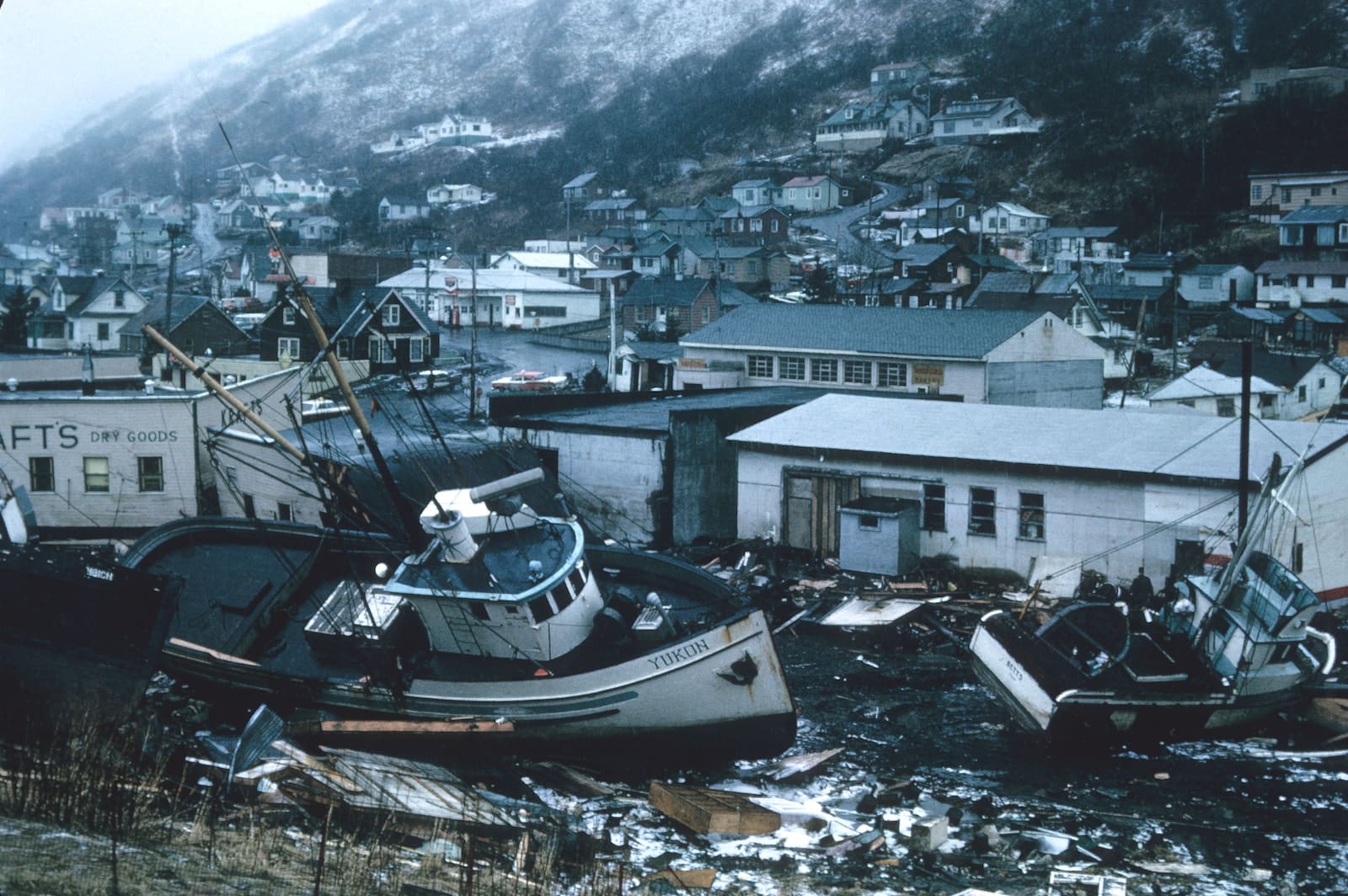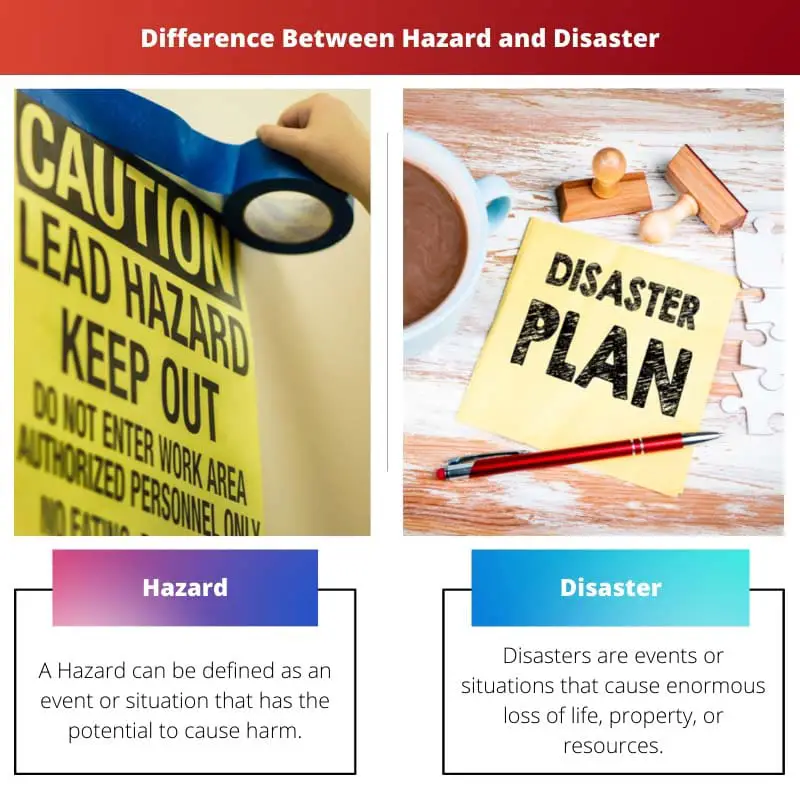Hazard and Disaster can be analyzed on the basics of different factors where one important factor is time, as it can either be long-term or short-term, and another is the probability of occurrence, which could be low or high. Both Hazard and Disaster are confusing, alike, and equivalent, yet they are distinguishable.
Key Takeaways
- Hazards are potential threats or events that can cause harm, while disasters realize those hazards, resulting in significant damage or loss.
- Hazards can be natural or human-made, while disasters result from one or more hazards affecting a vulnerable population.
- Risk management and mitigation strategies can help reduce the impact of hazards and prevent them from turning into disasters.
Hazard vs Disaster
The difference between Hazard and Disaster is that a Hazard can be defined as an event or situation that has the potential to cause harm, whereas, Disaster, on the other hand, are events or situation that cause enormous loss of life, property, or property resources.

The word Hazard is derived from the French word “haver,” which means “catch.” The risk element must be present for an event to be considered a Hazard. Moreover, A Hazard can be defined as an event or situation that has the potential to cause harm.
The word Diasater is defined as “a severe adverse event characterized by extreme loss of life, severe economic damage, or both. Moreover, it is a word that conjures up unsettling images. For instance, Disasters include earthquakes, hurricanes, tornadoes, tsunamis, and floods.
Comparison Table
| Parameters of Comparison | Hazard | Disaster |
|---|---|---|
| Definition | A Hazard can be defined as an event or situation that has the potential to cause harm. | Disasters are events or situations that cause enormous loss of life, property, or resources. |
| Upshot | It has less severe upshots. | It has severe upshots. |
| Period | It can be short-term. | It can be long-term. |
| Occurrence Probability | It can be predicted. | It cannot be predicted. |
| Example | Using machinery without knowing how it works or overexposure to harmful chemicals. | It includes earthquakes, hurricanes, tornadoes, tsunamis, and floods. |
What is Hazard?
A Hazard is anything that could cause injury, death, or damage to property. It can be environmental hazards like earthquakes, tornadoes, fires, and floods. It can also be caused by the way things are done at work or at home. For instance, using machinery without knowing how it works or overexposure to harmful chemicals. Moreover, there is an increase in injuries caused by something other than machinery, cuts to hands and feet.
The word Hazard is well-known as a possible source of danger or a source of possible loss or injury. Moreover, a Hazard can be defined as an event or situation that has the potential to cause harm. For instance, Floods themselves do not directly cause harm. However, the harmful consequences of flood occur if flood water damages one’s property or causes injury to people and their belongings. The flood is therefore considered a hazard only because there is the potential that it could cause damage.
Some of the Hazards are Health risks from chemicals and physical factors such as noise, vibration, or extremes of temperature. Environmental factors include dust exposure, fumes, noxious gases, radiation, and poor lighting. Workplace factors such as injuries from work tools, equipment, or machinery as well as from lifting, working at height, or working for a long time without a break.

What is Disaster?
A disaster is an event that causes tremendous damage and arrives so suddenly that it overwhelms local or national authorities and the people living in the neighbourhood. Disasters can happen anywhere and to anyone. They can be natural such as earthquakes and tsunamis, or human-made, such as war. Disasters can affect a single person, a business, a neighbourhood, or a country.
The word “Disaster” has come to mean a wide range of different things depending on context. It’s a word that conjures up unsettling images: of floods, fires, and famine. However, it is revealed that there are many different types of Disasters. For example, natural disasters are caused by forces of nature, such as earthquakes, floods, tornadoes, and volcanic eruptions. These are referred to as “Acts of God.” However, it is defined as a severe adverse event characterized by extreme loss of life and severe economic damage.
Man-made Disasters result from human actions, such as nuclear accidents or carelessness with hazardous materials. Technological disasters happen when technology doesn’t work properly or is destroyed in a catastrophe. With millions of people affected by Disasters in some way each year, the authorities choose a new natural disaster to be focused on each year. This allows the authorities to highlight how that particular disaster depends on the climate and what it means for countries around the world.

Main Differences Between Hazard and Disaster
- A Hazard can be defined as an event or situation that has the potential to cause harm, whereas, Disasters are events or situations that cause enormous loss of life, property, or resources.
- Hazards can have less severe upshots, whereas, Diasaters can have severe upshots.
- Hazards are well-known as short-term, whereas Disasters are well-known as long-term.
- The occurrence Probability of Hazards is predicted, whereas the occurrence Probability of Disasters cannot be predicted.
- For instance, hazards, using machinery without knowing how it works, or overexposure to harmful chemicals, whereas, For instance, Disasters include earthquakes, hurricanes, tornadoes, tsunamis, and floods.

- https://link.springer.com/article/10.1007/s10950-007-9083-x
- https://link.springer.com/article/10.1007/s10708-017-9825-4
- https://journals.sagepub.com/doi/abs/10.1177/0011392113484456

The content does an excellent job of providing comprehensive definitions of what Hazards and Disasters are. The examples of Hazards are particularly helpful in understanding the potential sources of danger and harm. It is well researched and informative.
The way the content differentiates between Hazards and Disasters is very insightful. It provides a clear definition of each and highlights the importance of risk management and mitigation strategies in reducing the impact of Hazards.
The parameters of comparing Hazard and Disaster are very well explained in the content. It allows us to understand the differences and similarities between the two concepts. The explanations provided are clear and concise, making the information easy to grasp.
The content covers all the key aspects of Hazards and Disasters, from definitions to examples and the difference in severity. The explanations are thorough and provide valuable insights into the potential risks and impacts associated with these events.
The content provides a thorough explanation of what constitutes a Hazard and a Disaster. It gives a clear understanding of the impact of these events and how they can affect vulnerable populations. The risk factors and occurrence probability are well explained.
The detailed comparison table helps to outline the differences between a Hazard and a Disaster. The examples provided are helpful in illustrating the concepts and applying them to real-life situations.
The detailed explanations provided in the content offer a comprehensive understanding of the differences between a Hazard and a Disaster. The information is well presented and supported by relevant references, adding credibility to the content.
The content did a great job of explaining the key takeaways and the comparison between Hazard and Disaster. It is useful to have a clear understanding of the risks associated with Hazards and the more severe consequences of Disasters.